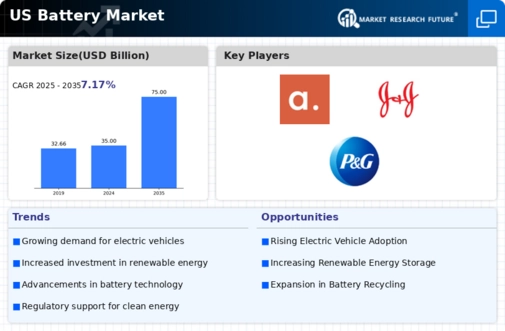Surge in Electric Vehicle Adoption
The increasing adoption of electric vehicles (EVs) is a primary driver for the battery market. As consumers and manufacturers shift towards sustainable transportation, the demand for high-capacity batteries is surging. In 2025, it is estimated that EV sales in the US will reach approximately 3 million units, representing a growth of around 25% from the previous year. This trend is likely to propel the battery market, as automakers require advanced battery technologies to enhance vehicle performance and range. Furthermore, the transition to EVs aligns with broader environmental goals, potentially leading to further investments in battery technology and infrastructure. The battery market is thus positioned to benefit significantly from this shift, as the need for efficient, long-lasting batteries becomes increasingly critical.
Increased Consumer Electronics Usage
The proliferation of consumer electronics is a notable driver of the battery market. With the rise of smartphones, tablets, and wearable devices, the demand for portable power sources continues to escalate. In 2025, the US consumer electronics market is anticipated to reach approximately $400 billion, with a substantial portion attributed to battery-operated devices. This growth is likely to stimulate innovations in battery technology, as manufacturers seek to produce lighter, more efficient batteries that can support longer usage times. The battery market is thus positioned to benefit from this trend, as companies strive to meet consumer expectations for performance and convenience in their electronic devices.
Growing Demand for Renewable Energy Storage
The increasing reliance on renewable energy sources, such as solar and wind, is creating a substantial demand for energy storage solutions, thereby impacting the battery market. In 2025, the US is projected to install over 20 GW of new energy storage capacity, primarily driven by the need to store intermittent renewable energy. This trend necessitates the development of advanced battery systems capable of efficiently storing and discharging energy. As utilities and businesses invest in energy storage solutions, the battery market is expected to expand significantly. The integration of batteries with renewable energy systems not only enhances grid stability but also supports the transition towards a more sustainable energy landscape.
Regulatory Support for Clean Energy Initiatives
Regulatory frameworks promoting clean energy initiatives are influencing the battery market. The US government has implemented various policies aimed at reducing carbon emissions and encouraging the adoption of clean technologies. For instance, tax incentives and grants for renewable energy projects are likely to drive investments in battery storage solutions. In 2025, it is estimated that federal and state incentives could exceed $5 billion, fostering growth in the battery market. These regulations not only support the development of advanced battery technologies but also create a favorable environment for manufacturers and consumers alike. As regulatory support continues, the battery market is expected to thrive, aligning with national goals for sustainability and energy efficiency.
Technological Advancements in Battery Chemistry
Innovations in battery chemistry are driving the evolution of the battery market. Research and development efforts are focused on enhancing energy density, reducing charging times, and improving overall battery lifespan. For instance, solid-state batteries are emerging as a promising alternative to traditional lithium-ion batteries, potentially offering higher energy densities and improved safety. The US battery market is witnessing investments exceeding $1 billion in R&D for next-generation battery technologies. These advancements not only cater to the growing demand for consumer electronics but also support the expanding EV sector. As technology continues to evolve, the battery market is likely to experience a transformation, with new products entering the market that meet the diverse needs of consumers and industries alike.














Leave a Comment